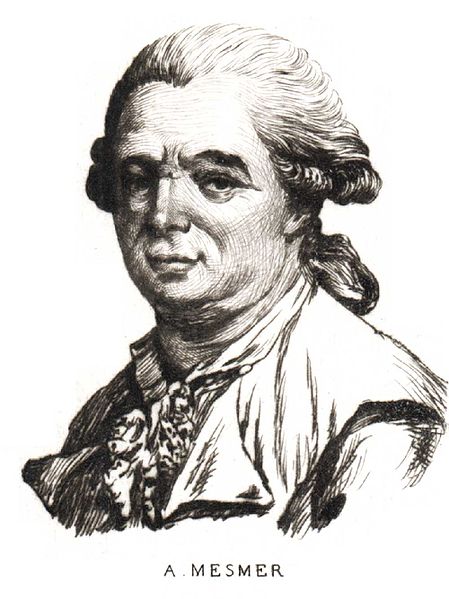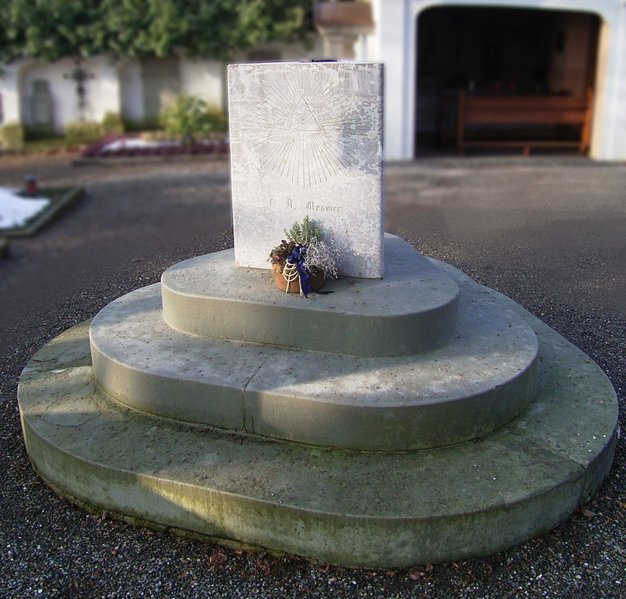<Back to Index>
- Physician Franz Anton Mesmer, 1734
- Painter Carl Heinrich Bloch, 1834
- General der Waffen SS Felix Martin Julius Steiner, 1896
PAGE SPONSOR


Franz Anton Mesmer (May 23, 1734 – March 5, 1815), sometimes, albeit incorrectly, referred to as Friedrich Anton Mesmer, was a German physician with an interest in Astronomy, who theorised that there was a natural energetic transference that occurred between all animated and inanimate objects that he called magnétisme animal (animal magnetism) and other spiritual forces often grouped together as mesmerism. The evolution of Mesmer's ideas and practices led Scottish surgeon James Braid to develop hypnosis in 1842. Mesmer's name is the root of the English verb "mesmerize".
Mesmer was born in the village of Iznang, on the shore of Lake Constance in Swabia, Germany, a son of master forester Anton Mesmer (1701 — after 1747) and his wife Maria / Ursula (1701 — 1770), née Michel. After studying at the Jesuit universities of Dillingen and Ingolstadt, he took up the study of medicine at the University of Vienna in 1759. In 1766 he published a doctoral dissertation with the Latin title De planetarum influxu in corpus humanum (On the Influence of the Planets on the Human Body), which discussed the influence of the Moon and the planets on the human body and on disease. This was not medical astrology — relying largely on Newton's theory of the tides — Mesmer expounded on certain tides in the human body that might be accounted for by the movements of the sun and moon. Evidence assembled by Frank A. Pattie suggests that Mesmer plagiarized his dissertation from a work by Richard Mead, an eminent English physician and Newton's friend. That said, in Mesmer's day doctoral theses were not expected to be original.
In
January 1768, Mesmer married Anna Maria von Posch, a wealthy widow, and
established himself as a physician in the Austrian capital Vienna.
In the summers he lived on a splendid estate and became a patron of the
arts. In 1768, when court intrigue prevented the performance of La Finta Semplice (K. 51) for which a twelve year old Wolfgang Amadeus Mozart had composed 500 pages of music, Mesmer is said to have arranged a performance in his garden of Mozart's Bastien und Bastienne (K. 50), a one act opera, though Mozart's biographer Nissen has
stated that there is no proof that this performance actually took
place. Mozart later immortalized his former patron by including a
comedic reference to Mesmer in his opera Così fan tutte. In
1774, Mesmer produced an "artificial tide" in a patient by having her
swallow a preparation containing iron, and then attaching magnets to
various parts of her body. She reported feeling streams of a mysterious
fluid running through her body and was relieved of her symptoms for
several hours. Mesmer did not believe that the magnets had achieved the
cure on their own. He felt that he had contributed animal magnetism, which had accumulated in his work, to her. He soon stopped using magnets as a part of his treatment. In 1775, Mesmer was invited to give his opinion before the Munich Academy of Sciences on the exorcisms carried out by Johann Joseph Gassner, a priest and healer,
and also a Swabian. Mesmer said that while Gassner was sincere in his
beliefs, his cures were because he possessed a high degree of animal
magnetism. This confrontation between Mesmer's secular ideas and
Gassner's religious beliefs marked the end of Gassner's career as well
as, according to Henri Ellenberger, the emergence of dynamic psychiatry. The scandal that followed Mesmer's unsuccessful attempt to treat the blindness of an 18 year old musician, Maria Theresia Paradis, led him to leave Vienna in 1777. The following year Mesmer moved to Paris,
rented an apartment in a part of the city preferred by the wealthy and
powerful, and established a medical practice. Paris soon divided into
those who thought he was a charlatan who had been forced to flee from
Vienna and those who thought he had made a great discovery. In his first years in Paris, Mesmer tried and failed to get either the Royal Academy of Sciences or the Royal Society of Medicine to
provide official approval for his doctrines. He found only one
physician of high professional and social standing, Charles d'Eslon, to
become a disciple. In 1779, with d'Eslon's encouragement, Mesmer wrote
an 88 page book Mémoire sur la découverte du magnétisme animal, to which he appended his famous 27 Propositions. These propositions outlined his theory at that time. According
to d'Eslon, Mesmer understood health as the free flow of the process of
life through thousands of channels in our bodies. Illness was caused by
obstacles to this flow. Overcoming these obstacles and restoring flow
produced crises, which restored health. When Nature failed
to do this spontaneously, contact with a conductor of animal magnetism
was a necessary and sufficient remedy. Mesmer aimed to aid or provoke
the efforts of Nature. To cure an insane person,
for example, involved causing a fit of madness. The advantage of
magnetism involved accelerating such crises without danger. Mesmer
treated patients both individually and in groups. With individuals he
would sit in front of his patient with his knees touching the patient's
knees, pressing the patient's thumbs in his hands, looking fixedly into
the patient's eyes. Mesmer made "passes", moving his hands from
patients' shoulders down along their arms. He then pressed his fingers
on the patient's hypochondrium region (the area below the diaphragm),
sometimes holding his hands there for hours. Many patients felt
peculiar sensations or had convulsions that were regarded as crises and
supposed to bring about the cure. Mesmer would often conclude his
treatments by playing some music on a glass armonica. By
1780 Mesmer had more patients than he could treat individually and he
established a collective treatment known as the "baquet". An English
physician who observed Mesmer described the treatment as follows: In
the middle of the room is placed a vessel of about a foot and a half
high which is called here a "baquet". It is so large that twenty people
can easily sit round it; near the edge of the lid which covers it,
there are holes pierced corresponding to the number of persons who are
to surround it; into these holes are introduced iron rods, bent at
right angles outwards, and of different heights, so as to answer to the
part of the body to which they are to be applied. Besides these rods,
there is a rope which communicates between the baquet and one of the
patients, and from him is carried to another, and so on the whole
round. The most sensible effects are produced on the approach of
Mesmer, who is said to convey the fluid by certain motions of his hands
or eyes, without touching the person. I have talked with several who
have witnessed these effects, who have convulsions occasioned and
removed by a movement of the hand... In 1784, without Mesmer requesting it, King Louis XVI appointed
four members of the Faculty of Medicine as commissioners to investigate
animal magnetism as practiced by d'Eslon. At the request of these
commissioners the King appointed five additional commissioners from the
Royal Academy of Sciences. These included the chemist Antoine Lavoisier, the physician Joseph - Ignace Guillotin, the astronomer Jean Sylvain Bailly, and the American ambassador Benjamin Franklin. The
commission conducted a series of experiments aimed, not at determining
whether Mesmer's treatment worked, but whether he had discovered a new
physical fluid. The commission concluded that there was no evidence for
such a fluid. Whatever benefit the treatment produced was attributed to
"imagination". As
said, the investigation of the commission was not conducted on Mesmer
himself, but on his work according to d'Eslon. Many affirmed that
d'Eslon didn't know completely the true system of Mesmer. Abbe Faria an
Indo - Portuguese monk in Paris contemporary of Mesmer emphasized that
“nothing comes from the magnetizer; everything comes from the subject
and takes place in his imagination i.e., autosuggestion generated from within the mind”. In
1785 Mesmer left Paris. In 1790 he was in Vienna again to settle the
estate of his deceased wife Maria Anna. When he sold his house in
Vienna in 1801 he was in Paris. Mesmer was driven into exile soon after
the investigations on animal magnetism. His exact activities during the
last twenty years of his life are largely unknown. He died in 1815.